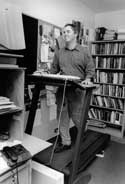Berkeley
- Pull up a rock.
| |

|
| |
Galen
Cranz may look like she's relaxing, but actually she's
hard at work |
| |

|
| |
Seth
Roberts prefers working at his computer while walking
on a treadmill |
The contemporary
office needs to be more Stone Age and less high tech, according
to a University of California, Berkeley, professor of architecture.
Galen Cranz,
who in 1998 wrote "The Chair: Rethinking Culture, Body and
Design," a book that berates the traditional chair as a source
of back pain and illness, now wants people to rethink office
furniture and design. She indicts almost all office furnishings
and is spreading her message as she teaches on the topic and
travels in search of the optimal workplace.
Offices
need less uniformity and more design, she said, to support
a wide range of seating options such as sitting up, lying
down, kneeling, squatting, sitting cross-legged or perching
halfway between sitting and standing. Workers need to exercise
more than one set of muscles usually used in the standard
seated position.
They even
need to move about sometimes, like hunters and gatherers,
said Cranz. Some people think better when in motion, she added,
and walking should be integrated into the workplace.
"We need
several different positions for working - something more like
a par course," she said. Instead, people are trained early
on to remain seated, Cranz said, noting that one of the first
lessons for youngsters starting school is to "sit still."
"The Stone
Age office, that's what we're designed for," she said.
Cranz said
her position is borne out by medical records showing that
back problems account for the primary reason workers call
in sick, as well as for the escalating numbers of cumulative
trauma disorders (previously known as repetitive stress injuries).
"My evidence is so compelling, people say, 'You know, she's
right. Maybe radical, but right,'" said Cranz.
Cranz is
teaming up with UC Berkeley associate professor of psychology
Seth Roberts to teach a course on the office of the future,
thanks to a Hewlett Foundation grant. It will be on the campus's
2001 class schedule.
"I guess
we both believe that sitting is bad for you," said Roberts.
On Aug. 27, 1996, Roberts decided to start working while standing
up. He raised his computer screen and keyboard so that he
could stand while writing and talking on the phone. About
a week later, he made an unexpected discovery - he was sleeping
much better. For many years, he had awakened too early in
the morning.
"After
I discovered how much standing a lot helped my sleep, then
I got a treadmill," Roberts said. He still works at least
eight hours a day while standing or walking.
This work
style makes sense for many people, Roberts says in a handbook
written with Reed College colleague Allen Neuringer in 1998.
The book, published by Plenum Press, is called "Handbook of
Research Methods in Human Operant Behavior."
"The muscles
we use to stand no doubt did more work in an average Stone
Age day than any other muscles," said Roberts. "Because we
sleep lying down, sleep time can be used to do routine maintenance
on these muscles. And if these muscles were shaped by evolution
to take advantage of sleep for maintenance, then they will
need sleep for maintenance...
"At the
time our sleep-controlling system evolved into the form it
now has, people probably stood many hours every day. Without
the pressure to sleep provided by considerable standing, sleep
is not deep enough."
While Roberts
said he is reluctant to make any sweeping recommendations
about offices and furniture, he thinks the topic merits further
study. He has checked out purported cutting-edge offices in
San Francisco, Los Angeles, Seattle, New York and London.
He said
he found a lot of flexibility, allowances for employees to
move from place to place within a work environment without
walls or assigned desks. Workers can plug in their laptops
at multiple stations of their own choosing.
"(The offices)
are not incredibly innovative, but they're modern," Roberts
said.
Many companies
breaking some of the unwritten rules of office design don't
want to pay the high cost of real estate for a building that
provides every worker with an individual space and desk, he
said, particularly when many workers are out of the office.
"We're
not just nervous systems," Cranz said. "We have mass, muscle
and joints and connective tissue and fluids that need movement.
We need to develop some type of cultural image to appreciate
and enjoy our three-dimensional nature.
"The computer
has amplified our nervous system and given us the metaphor
of the branch or tree diagram for the logic of our thinking,"
she said. "We push ourselves mentally, not wanting to pause
for breaks."
Cranz said
she's reminded of what someone once wrote about the difference
between travel by horseback versus using the automobile.
"Riding
on horseback was physically demanding," she said, "so people
looked forward to rest stops, whereas, in our case, we tend
to press on thinking we can 'get there' without a break, and,
of course, end up fatigued by lack of movement."